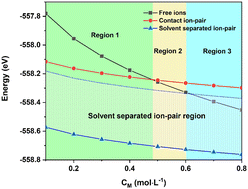Investigating the abnormal conductivity behaviour of divalent cations in low dielectric constant tetraglyme-based electrolytes†
Abstract
Solutions made of tetraglyme (G4) containing Ca(TFSI)2 have been studied as models to understand the solvation structure and the conductivity properties of multivalent ions in low dielectric constant ethereal electrolytes. These solutions have been characterised using electrochemical impedance spectroscopy, rheological measurement, and Raman spectroscopy. The ionic conductivity of these electrolytes shows an intriguing non-monotonic behaviour with temperature which deviates from the semi-empirical Vogel–Tammann–Fulcher equation at a critical temperature. This behaviour is observed for both Mg(TFSI)2 and Ca(TFSI)2, but not LiTFSI, indicating a difference in the solvation structure and the thermodynamic properties of divalent ions compared to Li+. The origin of this peculiar behaviour is demystified using temperature-controlled Raman spectroscopy and first-principles calculations combined with a thermodynamic analysis of the chemical equilibrium of Ca2+ ion-pairing versus solvation. As long-range electrostatic interactions are critical in solutions based on low dielectric ethereal solvents, a periodic approach is here proposed to capture their impact on the solvation structure of the electrolyte at different salt concentrations. The obtained results reveal that the thermodynamic and transport properties of Ca(TFSI)2/G4 solutions stem from a competition between enthalpic (ionic strength) and entropic factors that are directly controlled by the solution concentration and temperature, respectively. At high salt concentrations, the ionic strength of the solution favours the existence of free ions thanks to the strong solvation energy of the polydentate G4 solvent conjugated with the weak complexation ability of TFSI−. At elevated temperatures, the configurational entropy associated with the release of a coordinated G4 favours the formation of contact ion-pairs due to its flat potential energy surface (weak strain energy), offering a large configuration space. Such a balance between ion-pair association and dissociation not only rationalises the ionic conductivity behaviour observed for Ca(TFSI)2/G4 solutions, but also provides valuable information to extrapolate the ionic transport properties of other electrolytes with different M(TFSI)n salts dissolved in longer-chain glymes or even poly(ethylene oxide). These findings are essential for the understanding of solvation structures and ionic transport in low-dielectric media, which can further be used to design new electrolytes for Li-ion and post Li-ion batteries as well as electrocatalysts.

- This article is part of the themed collection: 2022 PCCP HOT Articles


 Please wait while we load your content...
Please wait while we load your content...